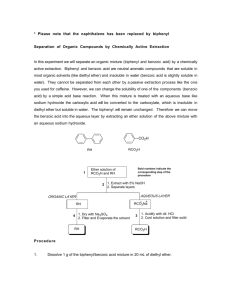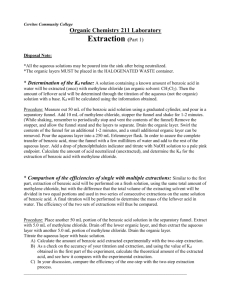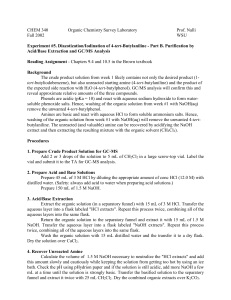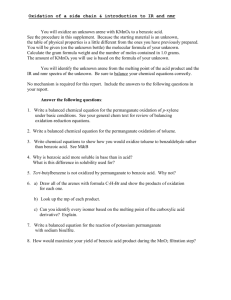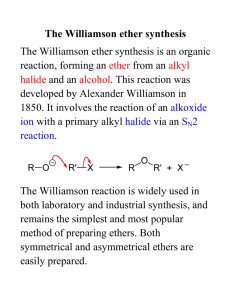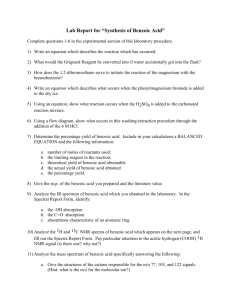Acid-Base Extraction: Organic Chemistry Lab
advertisement
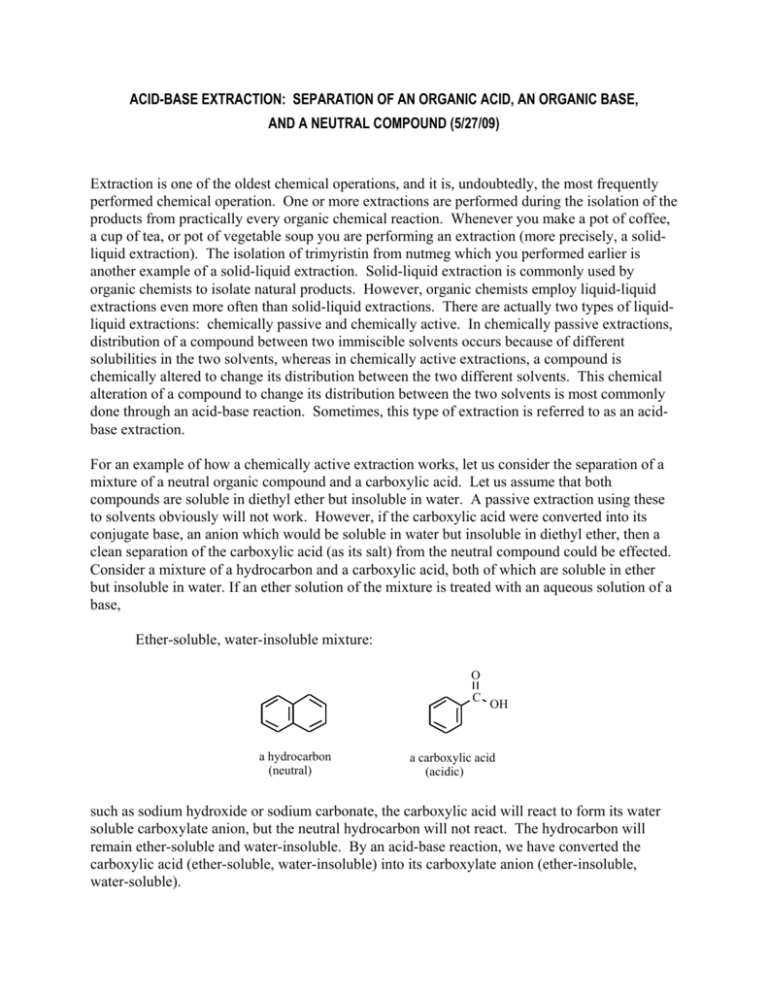
ACID-BASE EXTRACTION: SEPARATION OF AN ORGANIC ACID, AN ORGANIC BASE, AND A NEUTRAL COMPOUND (5/27/09) Extraction is one of the oldest chemical operations, and it is, undoubtedly, the most frequently performed chemical operation. One or more extractions are performed during the isolation of the products from practically every organic chemical reaction. Whenever you make a pot of coffee, a cup of tea, or pot of vegetable soup you are performing an extraction (more precisely, a solidliquid extraction). The isolation of trimyristin from nutmeg which you performed earlier is another example of a solid-liquid extraction. Solid-liquid extraction is commonly used by organic chemists to isolate natural products. However, organic chemists employ liquid-liquid extractions even more often than solid-liquid extractions. There are actually two types of liquidliquid extractions: chemically passive and chemically active. In chemically passive extractions, distribution of a compound between two immiscible solvents occurs because of different solubilities in the two solvents, whereas in chemically active extractions, a compound is chemically altered to change its distribution between the two different solvents. This chemical alteration of a compound to change its distribution between the two solvents is most commonly done through an acid-base reaction. Sometimes, this type of extraction is referred to as an acidbase extraction. For an example of how a chemically active extraction works, let us consider the separation of a mixture of a neutral organic compound and a carboxylic acid. Let us assume that both compounds are soluble in diethyl ether but insoluble in water. A passive extraction using these to solvents obviously will not work. However, if the carboxylic acid were converted into its conjugate base, an anion which would be soluble in water but insoluble in diethyl ether, then a clean separation of the carboxylic acid (as its salt) from the neutral compound could be effected. Consider a mixture of a hydrocarbon and a carboxylic acid, both of which are soluble in ether but insoluble in water. If an ether solution of the mixture is treated with an aqueous solution of a base, Ether-soluble, water-insoluble mixture: O C a hydrocarbon (neutral) OH a carboxylic acid (acidic) such as sodium hydroxide or sodium carbonate, the carboxylic acid will react to form its water soluble carboxylate anion, but the neutral hydrocarbon will not react. The hydrocarbon will remain ether-soluble and water-insoluble. By an acid-base reaction, we have converted the carboxylic acid (ether-soluble, water-insoluble) into its carboxylate anion (ether-insoluble, water-soluble). Formation of a water-soluble salt: O O C OH + C O OH ether-soluble water-insoluble + H2O ether-insoluble water-soluble By extraction of an ether solution containing a neutral compound and a carboxylic acid with an aqueous solution of sodium hydroxide, we can separate the two compounds. The neutral compound remains in the ether layer, while the carboxylic acid reacts with hydroxide ion to form the carboxylate anion, which dissolves in the water layer. The two layers are separated using a separatory funnel, and the aqueous layer is then acidified to regenerate the water-insoluble carboxylic acid. Recovery of the carboxylic acid: O O C C O + H carboxylate anion OH carboxylic acid Using a similar acid-base reaction, amines (organic bases) can be separated from neutral or acidic compounds by conversion into their conjugate acids, water-soluble cations. Thus treatment of an ether solution of a mixture containing an amine with an aqueous acid (e.g., hydrochloric acid) produces a water-soluble cation that can be separated from water-insoluble compounds. Formation of a water-soluble salt: RNH2 + ether-soluble water-insoluble H RNH3 ether-insoluble water-soluble After separation of the ether and water layers, the water layer is then treated with aqueous base to regenerate the water-insoluble amine. Recovery of the amine: RNH3 + ammonium cation OH RNH2 + H2O amine Because different conditions are used to convert acidic and basic organic compounds into watersoluble salts, the acid-base reactions we have discussed can be used to effect a number of types of chemically active extractions. The flow chart that follows outlines the steps involved in the separation of an organic acid (RCO2H), an organic base (RNH2), and a neutral compound (RH) by acid-base extractions. Solution of RCO 2 H, RNH2 , and RH in Organic Solvent Extract with dilute NaOH Aqueous layer RCO2 Organic Layer RNH2 and RH Make acidic, filter or extract with solvent Extract with dilute HCL Solid or solution of RCO2 H Aqueous layer RNH3 + Make basic, filter or extract with solvent Remove solvent Organic layer RH RCO2 H Aqueous layer discard Solid or solution of RNH2 Remove solvent RNH2 Remove Solvent RH Aqueous layer discard In this experiment, a mixture comprised of 0.5 g each of benzoic acid, p-nitroaniline, and anthracene will be separated into the individual components by acid-base extractions. All three components are soluble in dichloromethane (CH2Cl2) but only slightly soluble in cold water. NH2 CO2H O2N benzoic acid p-nitroaniline anthracene Procedure Obtain 1.5 g of a 1:1:1 mixture of benzoic acid, p-nitroaniline, and anthracene and dissolve it in 40 mL of dichloromethane in an Erlenmeyer flask. Pour this solution into a separatory funnel which has a teflon stopcock. (Use the addition funnel from your organic kit if necessary.) If small amounts of solid material do not dissolve, the solution should be gravity-filtered through a small cotton plug into the separatory funnel. Extract the organic solution with 25 mL of 2M sodium hydroxide solution. Separate the layers and extract the organic layer with a second 25 mL of 2M sodium hydroxide. Combine the basic extracts in an Erlenmeyer flask and label the flask "basic extract". Now similarly extract the organic layer twice with 25 mL portions of 6M hydrochloric acid. Combine the acidic extracts in a second Erlenmeyer flask and label the flask "acidic extract". Transfer the organic layer into a third Erlenmeyer flask and label the flask "neutral fraction". Add approximately 2-3 g of anhydrous sodium sulfate to this neutral fraction, swirl and let stand for at least 15 minutes with occasional swirling to hasten the drying. Cool the flasks containing the "acidic extract" and the "basic extract" in an ice-water bath. Neutralize the "acidic extract" by carefully adding 6M sodium hydroxide until the solution is distinctly basic to pH paper. Similarly, neutralize the "basic extract" by carefully adding concentrated (12M) hydrochloric acid until the solution is distinctly acidic to pH paper. Precipitates should form in each flask upon neutralization. The neutralizations will liberate considerable amounts of heat, so let the flasks stand in the ice-water bath until their contents are at, or below, room temperature. Collect each precipitate by vacuum filtration using a Buchner funnel and wash the filter cakes with a small amount of cold distilled water. Allow the collected solids to air-dry until the next laboratory period. Decant the "neutral fraction" from the sodium sulfate into a tared round-bottomed flask (the flask should be of sufficient size such that it will be no more than half-filled by the solution). Rinse the Erlenmeyer flask and the sodium sulfate with a small amount of dichloromethane, decanting it into the round-bottomed flask. Remove the solvent on a rotary evaporator. Reweigh the flask with its contents, determine the weight of the neutral material, and calculate a percent recovery. Transfer this neutral material to a labelled vial and store it until the next laboratory period. NEXT LAB After the base (p-nitroaniline) is dry, transfer it to labelled and tared vial. Reweigh the vial to determine the weight of the solid and calculate it’s percent recovery. After benzoic acid is dry, transfer it to a tared flask. Reweigh the flask to determine the weight of the solid and calculate it’s percent recovery. Recrystallize benzoic acid from a minimum amount of hot water. (Use the solubility data to calculate the approximate amount below, based on the grams you recovered.) Add an extra 2-5 mLs of hot water if there is still solid present after adding the minimum amount of solvent. If this does not dissolve the solid, you will need to perform a hot filtration (perform over a steam bath, use a small plug of cotton). Before cooling, heat on a hot plate to remove the extra solvent added prior to the hot filtration (if performed). Dry and weigh the crystals. Determine melting points for benzoic acid and p-nitroaniline and compare them to literature values. Separately, dissolve a small amount of each of the three compounds in chloroform and spot a silica gel TLC plate with these solutions. Develop the TLC plate using chloroform. Visualize the spots under both short and long wavelength UV light and record your observations. Please help conserve ice. Share with your bench partner when possible! Flush aqueous solutions down the sink w/ plenty of running water. Sodium hydroxide, hydrochloric acid are both aqueous. ¡ Write out the reactions for the extraction (e.g., C6H5-COOH + NaOH Æ C6H5-COO-Na+ + H2O) and think about the difference in solubility between the acid and base compounds vs. their salt forms. ¡ Before lab, calculate the moles of benzoic acid and 2M NaOH you will use to extract it with. Then calculate the amount of concentrated (12M) HCl it will take to neutralize it. Include these amounts in the reagent table of your pre lab. Do likewise for p-nitroaniline! ¡ The melting points of benzoic acid and p-nitroaniline are important physical constants for this experiment (and therefore belong in the reagent table of your prelab)! ¡ Read all applicable techniques in your lab text (Zubrick) and otherwise prepare well for this lab experiment! SOLUBILITY DATA COMPOUND Benzoic Acid p-Nitroaniline Anthracene TEMPERATURE SOLUBILITY IN WATER (g/100mL) 0 ºC 0.17 20 ºC 0.29 90 ºC 4.55 0 ºC 0.08 100 ºC 2.22 78 ºC 1.49 (IN ETHANOL) Name:_____________________________________________Section:___________Date:___________ POSTLAB EXERCISE ACID-BASE EXTRACTION: SEPARATION OF AN ORGANIC ACID, AN ORGANIC BASE, AND A NEUTRAL COMPOUND (6/5/09) >> Due the lab following the completion of the experimental protion of the notebook (30pts. TOTAL). Please answer questions on this form.<< A. PRODUCT INFORMATION (15pts) %Recovery (relative to the amount in initial mixture (6pts): Benzoic Acid (5pts) p-Nitroaniline (5pts) Anthracene (4pts) (2pts) (2pts) (2pts) BEFORE Purification: AFTER Purification: Melting (1pt) Point (2pts): (1pt) Appearance (describe) (4pts): (2pts) (2pts) X (0pts – n/a) (2pts) (1pt) All Vials Properly Labeled B. SUMMARY QUESTIONS (15pts) 1. (2pts) Which of the three compounds you separated in this experiment dissolved in aqueous NaOH? Which compound dissolved in aqueous HCl? Which compound was left in the dichloromethane? 2. (2pts) Explain how benzoic acid was recoved from extracted solution: How was p-nitroaniline recovered? 3. (2pts) The percent recovery for benzoic acid is usually lower than the percent recovery for pnitroaniline. Comparing percent recoveries before purification, explain why this is true: Which compound had the highest recovery? 4. (2pts) How was benzoic acid purified? 5. (2pts) Which compound showed the largest Rf value? Which compound showed the smallest Rf value? Which compound fluoresced under longwave UV light? 6. (2pt) On the basis of what you have learned in this experiment, plus the information that phenol is soluble in aqueous NaOH but not in aqueous NaHCO3, whereas benzoic acid is soluble in both, draw a flow diagram showing how you would separate a mixture of benzoic acid, phenol, and aniline and attach it to this exercise. 7. (3pts) The pKa of benzoic acid is 4.19. Explain whether or not precipitation of benzoic acid from an aqueous solution of benzoate anion would be complete if hydrochloric acid is added until a pH of 7 is obtained.

